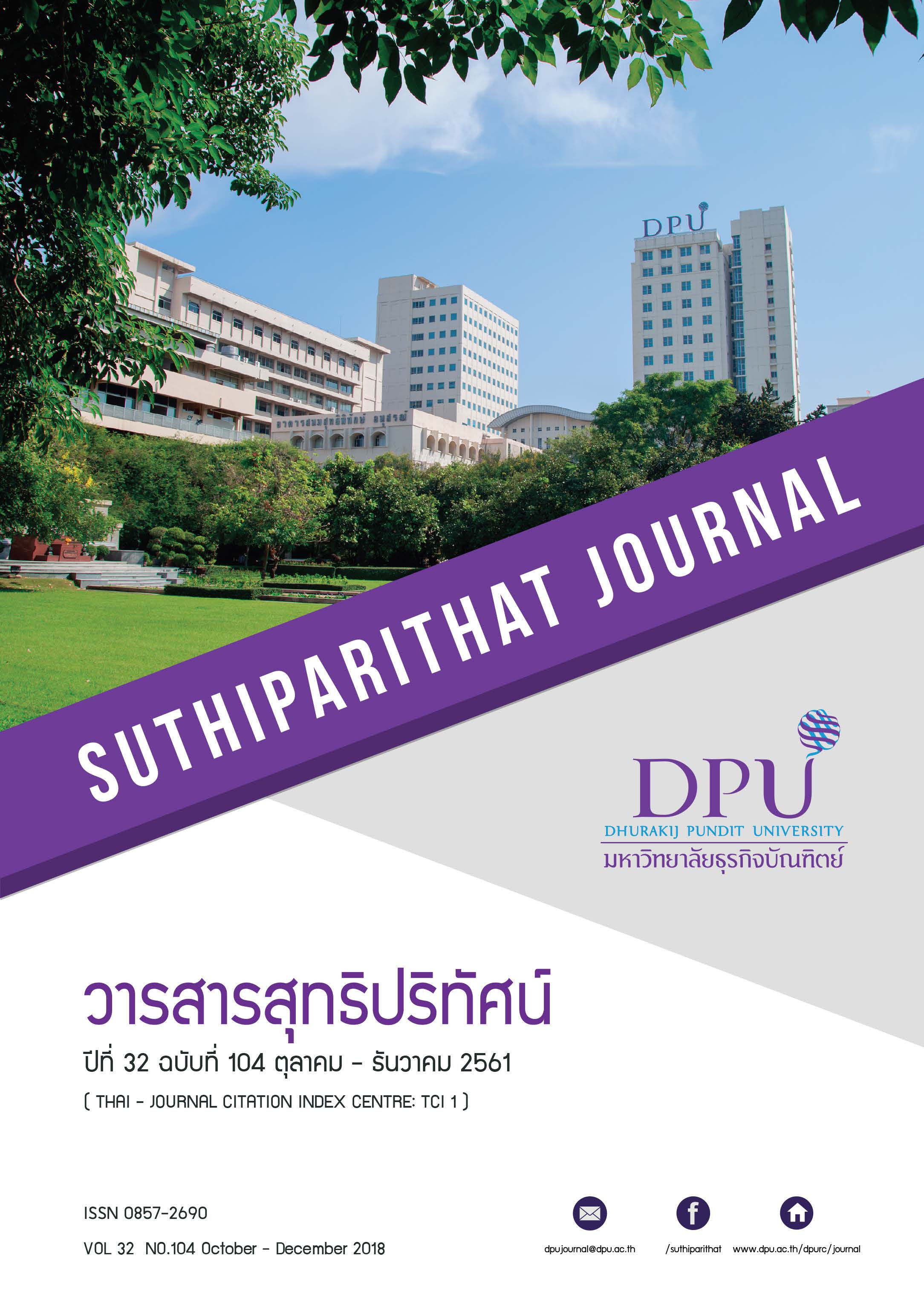คุณลักษณะที่พึงปรารถนาของผู้สอนวิชาภาษาอังกฤษในระดับอุดมศึกษา: กรณีศึกษามหาวิทยาลัยธุรกิจบัณฑิตย์
คำสำคัญ:
คุณลักษณะที่พึงปรารถนา, อาจารย์สอนภาษาอังกฤษในฐานะภาษาต่างประเทศ, การสอนภาษาอังกฤษบทคัดย่อ
การวิจัยนี้มีวัตถุประสงค์ 1) เพื่อสำรวจความคิดเห็นของนักศึกษามหาวิทยาลัยธุรกิจบัณฑิตย์เกี่ยวกับคุณลักษณะที่พึงปรารถนาของอาจารย์สอนภาษาอังกฤษ และ 2) เพื่อเปรียบเทียบความคิดเห็นของนักศึกษาเกี่ยวกับคุณลักษณะที่พึงปรารถนาของอาจารย์สอนภาษาอังกฤษ โดย จำแนกตามเพศ และคณะวิชาที่ศึกษา กลุ่มตัวอย่างที่ใช้ในการศึกษาคือ นักศึกษามหาวิทยาลัยธุรกิจบัณฑิตย์ ที่ลงทะเบียนเรียนในรายวิชาภาษาอังกฤษเพื่อจุดประสงค์เฉพาะ 2 ภาคเรียนที่ 2 ปีการศึกษา 2558 จำนวน 1,179 คน เครื่องมือที่ใช้ในการเก็บข้อมูลได้แก่ แบบสอบถามความคิดเห็นเกี่ยวกับคุณลักษณะที่พึงปรารถนาของอาจารย์สอนภาษาอังกฤษ จำนวน 5 ด้าน รวม 34 ข้อ สถิติที่ใช้ในการวิเคราะห์ข้อมูล ได้แก่ ค่าร้อยละ ค่าเฉลี่ย ค่า t-test และค่า f-test ผลการวิจัยพบว่า 1) ระดับความคิดเห็นเกี่ยวกับคุณลักษณะที่พึงปรารถนาของอาจารย์สอนภาษาอังกฤษ มหาวิทยาลัยธุรกิจบัณฑิตย์ ทั้งโดยรวมและรายด้านอยู่ในระดับมาก โดยได้ให้ความสำคัญกับด้านการวัดและประเมินผลเป็นลำดับแรก 2) นักศึกษาชายและนักศึกษาหญิง มีความคิดเห็นเกี่ยวกับคุณลักษณะที่พึงปรารถนาของอาจารย์สอนภาษาอังกฤษไม่แตกต่างกันอย่างมีนัยสำคัญทางสถิติ อย่างไรก็ตามนักศึกษาจากคณะวิชาที่ต่างกัน มีมุมมองในเรื่องคุณลักษณะที่พึงปรารถนาของอาจารย์สอนภาษาอังกฤษแตกต่างกันอย่างมีนัยสำคัญทางสถิติที่ระดับ 0.05 ในด้านการวัดและประเมินผล และด้านบุคลิกภาพ 3) จากข้อมูลบันทึกประสบการณ์และความรู้สึก ที่มีต่อผู้สอนภาษาอังกฤษ พบว่า การเอาใจใส่ การมีมนุษยสัมพันธ์ที่ดี ตลอดจนการส่งเสริมให้นักศึกษา มีส่วนร่วมในชั้นเรียน ถือเป็นคุณสมบัติที่สำคัญของอาจารย์สอนภาษาอังกฤษ
เอกสารอ้างอิง
Arikan, A., Taser, D., & Sarac-Suzer, H. S. (2008). The effective English language teacher from the perspectives of Turkish preparatory school students. Education and Science, 33(150), 42-51.
Benson, L., Schroeder, P., Lantz, C., & Bird, M. (2001). Student perceptions of effective teachers. Retrieved March 3, 2018, from http://www.usfca.edu/ess/sym2001/PDFbooks/naspe/naspep53-56.pdf.
Borg, S. (2006). The distinctive characteristics of foreign language teachers. Language Teaching Research, 10(1), 3-31.
Chen, Y. J., & Lin, S. C. (2009). Exploring characteristics of effective EFL teacher from the perceptions of junior high school students in Tainan. STUT Journal of Humanities and Social Sciences, 2, 219-249.
Deuter, M., Bradbery, J., & Turnbull, J., Eds. (2015). Oxford Advanced Learner’s Dictionary (9th ed.). Oxford: Oxford University Press.
Dincer, A., Takkac, A., & Yazici, M. (2013). Common characteristics of an effective English language teacher. The International Journal of Educational Researchers, 4(3), 1-8.
Husain, M., & Khan, S. (2016). Students’ feedback: An effective tool in teachers’ evaluation system. Retrieved June 13, 2018, from https://www.ncbi.nlm.nih.gov/pmc/articles/PMC4979299/
Jabbarifar, T. (2009). The importance of classroom assessment and evaluation in educational system. Retrieved March 3, 2018, from https://my.laureate.net/Faculty/docs/Faculty%20Documents/INTI%20Conferences/Parallel%20Sessions%204/4C/4C-03-P142%20(Iran).pdf.
Kaur, R. (2012). Role of 21st century teachers. Retrieved June 12, 2018, from http://crsinquisitiveminds.blogspot.com/
Markley, T. (2004). Defining the effective teacher: Current arguments in education. Essays in Education, 11(3), 1-14.
Meksophawannagul, M. (2015). Teacher and learner views on effective English teaching in the Thai context: The case of engineering students. English Language Teaching, 8(11), 99-116.
Park, G., & Lee, H. (2006). Characteristics of effective teachers perceived by high school teachers and students in Korea. Asia Pacific Education Review, 7(2), 236-248.
Pettis, J. (1997). Developing our professional competence: Some reflections. TESL Canada Journal, 16(2), 67-71.
Ratanapumma, K., & Anuyahong, B. (2015). Desired characteristics of English instructors perceived by Thai-Nichi Institute of Technology students. Proceedings of the International Conference on Language, Education and Psychology (pp. 54-67). Seoul: South Korea.
Saiki, R. (2006). Communicating effectively: Teaching lessons about dress for the workplace. Journal of Family and Consumer Sciences Education, 24(1), 1-13.
Sampson, E. C. (2016). Teachers’ Perceptions of the Effect of Their Attire on Middle-School Students’ Behavior and Learning. Retrieved June 20, 2018, from https://scholarworks.waldenu.edu/cgi/viewcontent.cgi?article=3181&context=dissertations
Sanderson, D. (1983). Modern language teachers in action: A report on classroom practice. York: Language. Materials Development Unit of the University of York.
Shishavan, H. B., & Sadeghi, K. (2009). Characteristics of an effective English language teacher as perceived by Iranian teachers and learners of English. English Language Teaching, 2(4), 130-143.
Stephens, P., & Crawley, T. (1994). Becoming an effective teacher. England: Stanley Thorns.
Wichadee, S. (2010). Defining the effective English language teacher: Students’ and teachers’ perspectives. In A.M.Stoke (Ed.), Proceeding of JALT2009 Conference (pp. 27-35). Tokyo: JALT.
ดาวน์โหลด
เผยแพร่แล้ว
รูปแบบการอ้างอิง
ฉบับ
ประเภทบทความ
สัญญาอนุญาต
เนื้อหาและข้อมูลในบทความที่ลงตีพิมพ์ในวารสารสุทธิปริทัศน์ ถือเป็นข้อคิดเห็นและความรับผิดชอบของผู้เขียนบทความโดยตรงซึ่งกองบรรณาธิการวารสาร ไม่จำเป็นต้องเห็นด้วย หรือร่วมรับผิดชอบใด ๆ
บทความ ข้อมูล เนื้อหา รูปภาพ ฯลฯ ที่ได้รับการตีพิมพ์ในวารสารสุทธิปริทัศน์ ถือเป็นลิขสิทธิ์ของวารสารสุทธิปริทัศน์หากบุคคลหรือหน่วยงานใดต้องการนำทั้งหมดหรือส่วนหนึ่งส่วนใดไปเผยแพร่ต่อหรือเพื่อกระทำการใด ๆ จะต้องได้รับอนุญาตเป็นลายลักษณ์อักษรจากวารสารสุทธิปริทัศน์ก่อนเท่านั้น







